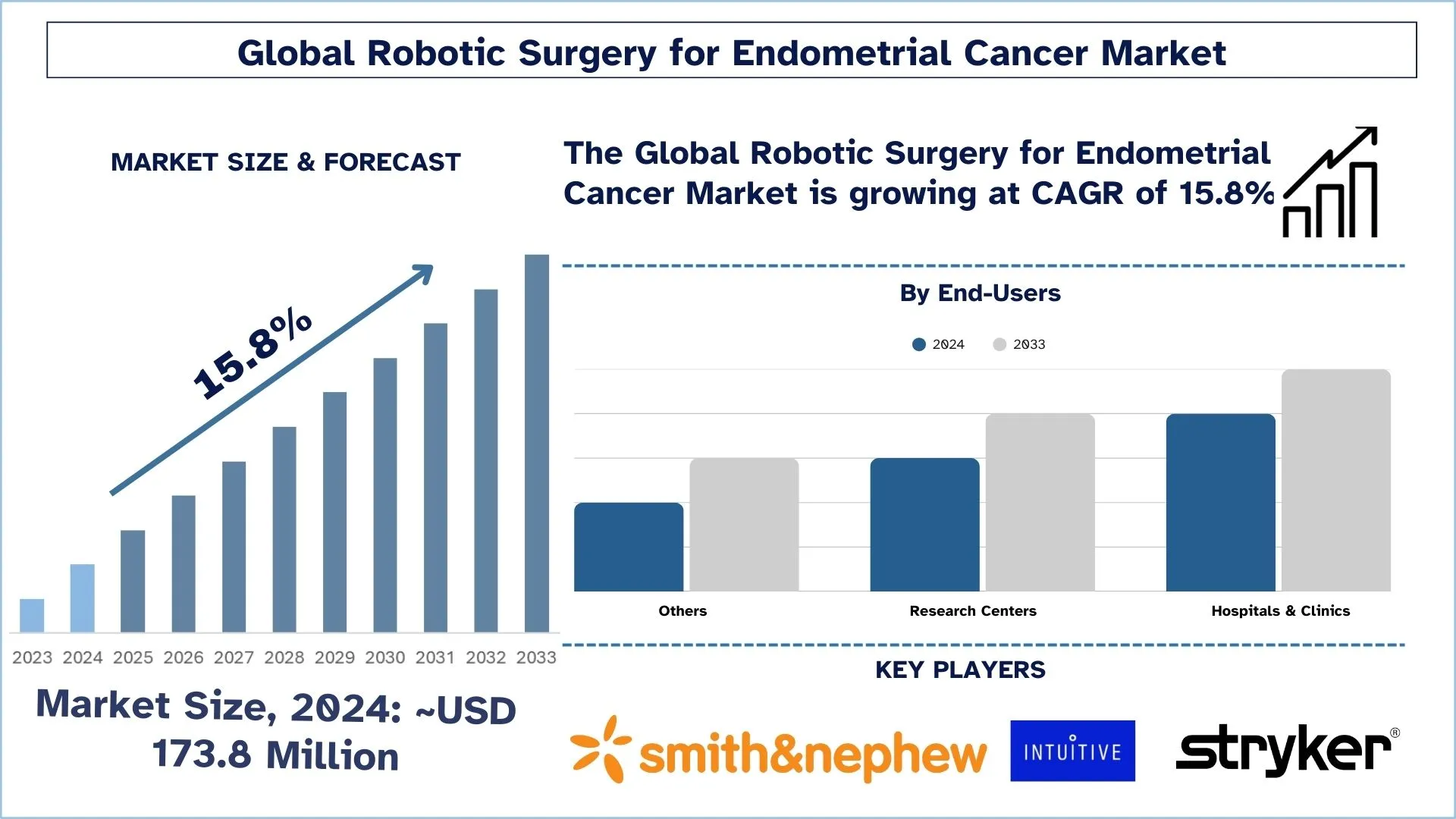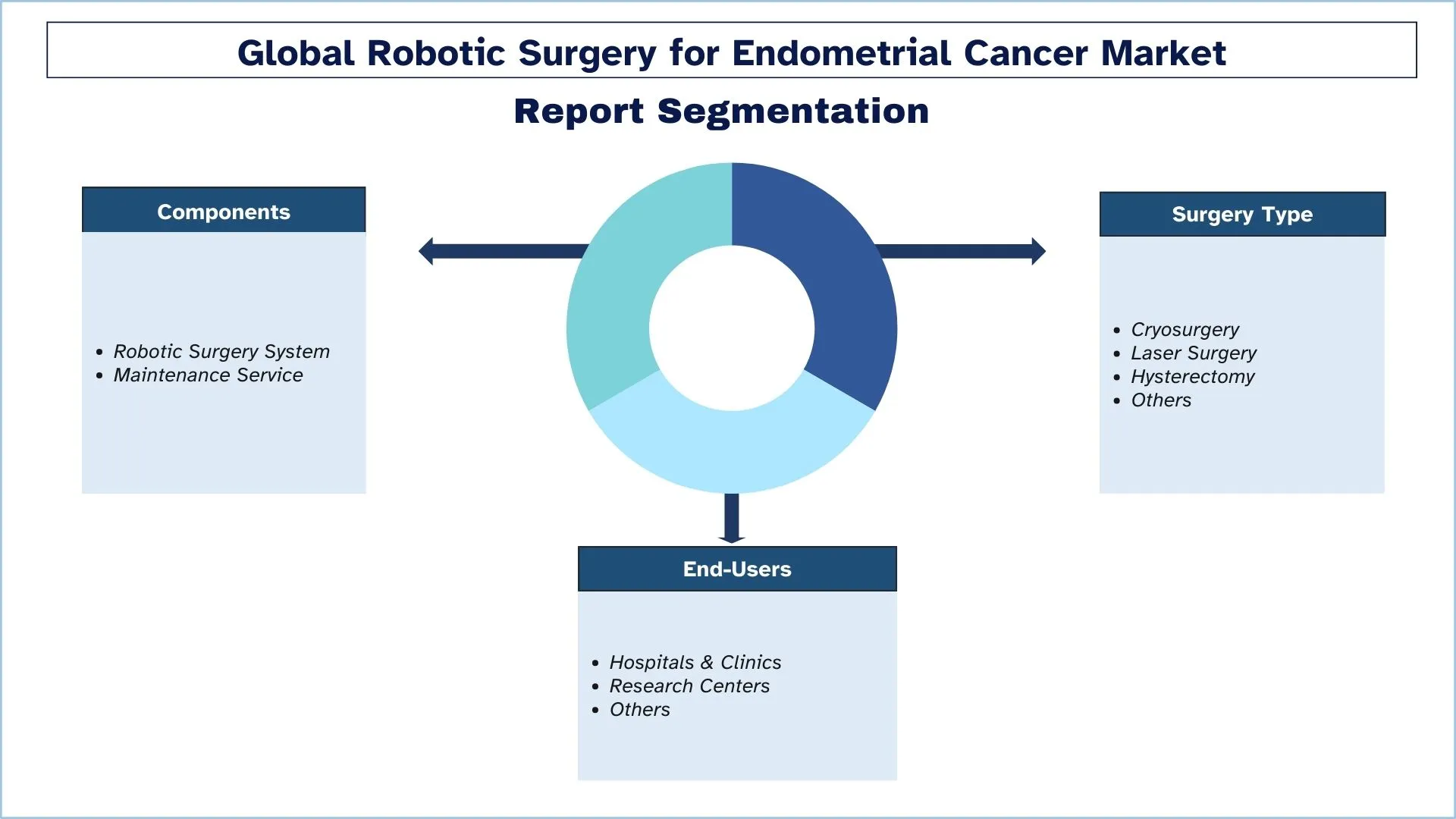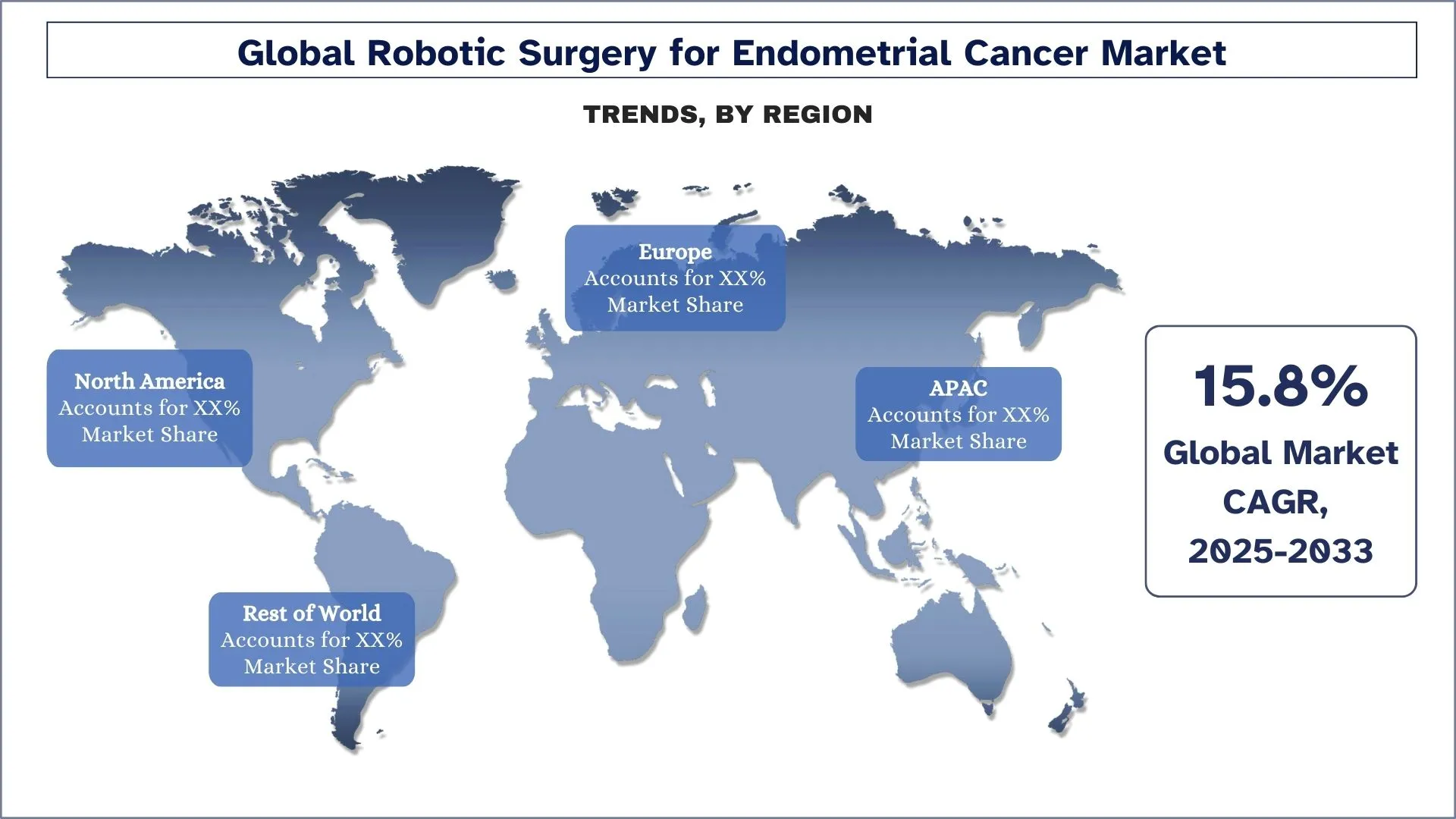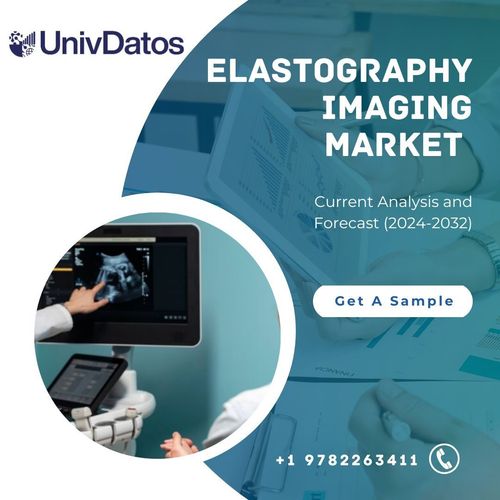Robotic Surgery For Endometrial Cancer Market: Current Analysis and Forecast (2025-2033)
Emphasis on Components (Robotic Surgery Systems and Maintenance Services); Surgery Type (Cryosurgery, Laser Surgery, Hysterectomy, and Others); End-Users (Hospitals & Clinics, Research Centers, and Others); and Region/Country

Robotic Surgery for Endometrial Cancer Market Size & Forecast
The Robotic Surgery for Endometrial Cancer Market was valued at approximately USD 173.8 million in 2024 and is expected to grow at a substantial CAGR of around 15.8% during the forecast period (2025-2033), owing to technological advancements in robotic surgical systems.
Robotic Surgery for Endometrial Cancer Market Analysis
Robotic surgery for endometrial cancer represents a cutting-edge and minimally invasive approach to the treatment of this gynecologic malignancy. Utilizing advanced robotic technology, this technique enables highly precise and intricate procedures with enhanced visualization and dexterity, surpassing the limitations of traditional laparoscopic surgery. The procedure involves a skilled surgeon controlling robotic arms equipped with miniature instruments, facilitating access to hard-to-reach areas while minimizing incision size. As a result, patients experience reduced postoperative pain, shorter hospital stays, and quicker recovery times. The developing healthcare infrastructure, along with the integration of advanced technology with the healthcare systems, are the major contributing factors for the market growth of robotic surgery for endometrial cancer. Systems such as Medtronic’s Hugo RAS systems are designed to make robotic-assisted surgery more possible. These systems provide modular, portable, enhanced visualization, and instrumentation to surgeons. The ease of surgery and increased preference for advanced surgical systems such as Hugo RAS by surgeons are the major factors responsible for the growth of robotic surgery for endometrial cancer in the nation.
Robotic Surgery for Endometrial Cancer Market Trends
This section discusses the key market trends influencing the various segments of the Robotic Surgery for Endometrial Cancer Market as identified by our research experts.
Shift Toward Minimally Invasive Procedures
There is an increasing and continuous tendency to perform endometrial cancer surgeries with minimal invasiveness, and this is because the patients and medical practitioners nowadays prefer undergoing procedures that are not very invasive and that can be done in a short duration of time and with minimal complications such as those that would require a longer stay in the hospital. Hysterectomy and lymphadenectomy are examples of MARS, which are used frequently due to better vision, better control, and better position of the surgeon, providing better results. This trend is further fueled by the escalating awareness of the advantages of minimization of invasive procedures, emerging evidence of clinical recommendations, and the growing customer-oriented approach to health care with a focus on the time to recover and quality of life.
Robotic Surgery for Endometrial Cancer Industry Segmentation
This section provides an analysis of the key trends in each segment of the global Robotic Surgery for Endometrial Cancer Market report, along with forecasts at the global, regional, and country levels for 2025-2033.
The Maintenance Services Segment Holds the Largest Share of the Robotic Surgery for Endometrial Cancer Market.
Based on components, the market is segmented into robotic surgery systems and maintenance services. Among them, the maintenance services segment is expected to grow to a higher CAGR during the forecast period. The maintenance services are expected to grow with a higher CAGR. The increasing adoption of the robotic surgery system that requires maintenance services for better operation is the major reason for the fast growth of maintenance services during the forecast period. The services, such as preventive maintenance, repairs & replacements, software upgrades, and system optimization, play a crucial role in ensuring the long-term reliability, safety, and performance of these advanced surgical technologies, thereby benefiting patients undergoing robotic surgery for endometrial cancer. As a result, the maintenance service segment is expected to witness growth with a higher CAGR during the forecast period.
The Laser Surgery Market is Expected to Witness a Higher CAGR than the Robotic Surgery for Endometrial Cancer Market.
Based on surgery type, the market is segmented into cryosurgery, laser surgery, hysterectomy, trachelectomy, and others. Among them, the laser surgery segment is expected to grow with a higher CAGR during the forecast period. Laser surgery is a minimally invasive technique that uses a high-energy laser beam to precisely remove or destroy tissue. Laser surgery can minimize damage to surrounding healthy tissue, which can lead to faster healing and less pain compared to traditional surgical techniques. Additionally, laser surgery can be used to precisely target and remove cancerous tissue, which can improve the chances of complete removal of the cancer. Further, the increased product launches and research & development in robot-assisted laser surgeries are the major attributing factors for the growth of the market. For instance, Researchers at the National Robotarium, a partnership between Heriot-Watt University and the University of Edinburgh, industry partners, and Edinburgh-based clinicians are developing laser-based novel robotic surgical techniques to improve surgical outcomes and patient care in cancer. The breakthrough method was awarded USD 1.59 million and was funded by the Engineering and Physical Sciences Research Council, part of UK Research and Innovation.

Asia Pacific has a significant share of the market in 2024.
Asia Pacific is expected to grow with the highest CAGR Robotic Surgery for Endometrial Cancer market during the forecast period. The market growth in this region is attributed to factors such as an increasing prevalence of endometrial cancer, rising awareness of robotic surgical options, improvements in healthcare infrastructure, and the adoption of advanced medical technologies. Furthermore, the region is also witnessing rapidly increasing cases of uterine cancer is a major factor in the market growth of robotic surgery for endometrial cancer in the Asia-Pacific. For example, according to WHO, each year, more than 2.3 million people are diagnosed with cancer in the South East Asia Region, and about 1.4 million die of the disease.
China Dominates the APAC Robotic Surgery for Endometrial Cancer Market
The robotic surgery market for eradicating endometrial cancer is rapidly growing in China due to the government’s support for technology advancements in the healthcare sector. The guidelines, including “Made in China 2025” and “Development Plan of Medical Equipment Industry”, help the development of surgical robotics through promotion of Chinese innovation, investment, as well as the speeding up of the approval processes. The utilisation of robotic surgeries, including hysterectomy and lymphadenectomy, is on the rise due to enhanced awareness of minimally invasive procedures, advanced artificial intelligence, and 5G connected surgical systems, development of considerably cheaper domestic robotic systems. These variables are collectively contributing to the development of China as a centre for innovative treatment of gynecologic cancer using the robotic methodology.

Robotic Surgery for Endometrial Cancer Industry Competitive Landscape
The Robotic Surgery for Endometrial Cancer Market is competitive, with several global and international players. The key players are adopting different growth strategies to enhance their market presence, such as partnerships, agreements, collaborations, new product launches, geographical expansions, and mergers and acquisitions.
Top Robotic Surgery for Endometrial Cancer Companies
Some of the major players operating in the market are Intuitive Surgical; Stryker; Accuray Incorporated; NuVasive, Inc; Smith+Nephew; Asensus Surgical US, Inc.; Medtronic; Auris Health, Inc.; Siemens Healthcare GmbH; and Renishaw plc.
Recent Developments in the Robotic Surgery for Endometrial Cancer Market
In August 2024, GSK plc announced U.S. FDA approval of Jemperli (dostarlimab) plus chemotherapy for all adult patients with primary advanced or recurrent endometrial cancer. This strategic launch helped the company to strengthen its product portfolio and enhance its revenue growth.
In June 2024, AstraZeneca’s Imfinzi in combination with carboplatin and paclitaxel has been approved in the U.S. for adult patients with primary advanced or recurrent endometrial cancer that is mismatch repair deficient. This approval helped the company to broaden its product portfolio and generate revenue.
Robotic Surgery for Endometrial Cancer Market Report Coverage
Report Attribute | Details |
Base year | 2024 |
Forecast period | 2025-2033 |
Growth momentum | Accelerate at a CAGR of 15.8% |
Market size 2024 | USD 173.8 Million |
Regional analysis | North America, Europe, Asia-Pacific, Rest of the World |
Major contributing region | APAC is expected to grow to the highest CAGR during the forecasted period. |
Key countries covered | U.S., Canada, Germany, France, UK, Spain, Italy, China, Japan, and India |
Companies profiled | Intuitive Surgical; Stryker; Accuray Incorporated; NuVasive, Inc; Smith+Nephew; Asensus Surgical US, Inc.; Medtronic; Auris Health, Inc.; Siemens Healthcare GmbH; and Renishaw plc. |
Report Scope | Market Trends, Drivers, and Restraints; Revenue Estimation and Forecast; Segmentation Analysis; Demand and Supply Side Analysis; Competitive Landscape; Company Profiling |
Segments Covered | By Components, By Surgery Type, By End-Users, By Region/Country |
Reasons to Buy the Robotic Surgery for Endometrial Cancer Market Report:
The study includes market sizing and forecasting analysis validated by authenticated key industry experts.
The report presents a quick review of overall industry performance at a glance.
The report covers an in-depth analysis of prominent industry peers with a primary focus on key business financials, product portfolios, expansion strategies, and recent developments.
Detailed examination of drivers, restraints, key trends, and opportunities prevailing in the industry.
The study comprehensively covers the market across different segments.
Deep dive regional-level analysis of the industry.
Customization Options:
The global robotic surgery for endometrial cancer market can be customized further as per the requirement or any other market segment. Besides this, UnivDatos understands that you may have your own business needs; hence, feel free to contact us to get a report that completely suits your requirements.
Table of Contents
Research Methodology for Robotic Surgery for Endometrial Cancer Market Analysis (2023-2033)
We analyzed the historical market, estimated the current market, and forecasted the future market of the global Robotic Surgery for Endometrial Cancer Market to assess its application in major regions worldwide. We conducted exhaustive secondary research to gather historical market data and estimate the current market size. To validate these insights, we carefully reviewed numerous findings and assumptions. Additionally, we conducted in-depth primary interviews with industry experts across the Robotic Surgery for Endometrial Cancer value chain. After validating market figures through these interviews, we used top-down and bottom-up approaches to forecast the overall market size. We then employed market breakdown and data triangulation methods to estimate and analyze the market size of industry segments and sub-segments.
Market Engineering
We employed data triangulation techniques to finalize the overall market estimation and derive precise statistical numbers for each segment and sub-segment of the global Robotic Surgery for Endometrial Cancer Market. We split the data into several segments and sub-segments by analyzing various parameters and trends, including components, surgery type, end-users, and regions within the global Robotic Surgery for Endometrial Cancer Market.
The main objective of the Global Robotic Surgery for Endometrial Cancer Market Study is to
The study identifies current and future trends in the global Robotic Surgery for Endometrial Cancer Market, providing strategic insights for investors. It highlights regional market attractiveness, enabling industry participants to tap into untapped markets and gain a first-mover advantage. Other quantitative goals of the studies include:
Market Size Analysis: Assess the current and forecast market size of the global Robotic Surgery for Endometrial Cancer Market and its segments in terms of value (USD).
Robotic Surgery for Endometrial Cancer Market Segmentation: The study segments the market by components, surgery type, end-users, and region.
Regulatory Framework & Value Chain Analysis: Examine the regulatory framework, value chain, customer behavior, and competitive landscape of the Robotic Surgery for Endometrial Cancer industry.
Regional Analysis: Conduct a detailed regional analysis for key areas such as Asia Pacific, Europe, North America, and the Rest of the World.
Company Profiles & Growth Strategies: Company profiles of the Robotic Surgery for Endometrial Cancer Market and the growth strategies adopted by the market leaders to sustain the fast-growing market.
Frequently Asked Questions FAQs
Q1: What is the Robotic Surgery for Endometrial Cancer Market's current size and growth potential?
As of 2024, the global robotic surgery for endometrial cancer market is valued at approximately USD 173.8 million and is expected to grow at a CAGR of 15.8% through 2033.
Q2: What are the driving factors for the growth of the Robotic Surgery for Endometrial Cancer Market?
Continuous innovation like improved dexterity, 3D imaging, and AI-assisted navigation enhances surgical precision, reduces recovery times, and drives adoption among gynecologic oncologists.
Q3: Which segment has the largest share of the robotic surgery for endometrial cancer market by end-users?
The Hospitals & Clinics segment currently holds the largest market share in the end-users segment.
Q4: What are the major trends in the Robotic Surgery for Endometrial Cancer Market?
There's a growing preference for less invasive treatment options among both patients and providers, boosting demand for robotic-assisted hysterectomies and lymphadenectomies in endometrial cancer cases.
Q5: Which region will dominate the Robotic Surgery for Endometrial Cancer market?
APAC leads the global Robotic Surgery for Endometrial Cancer Market.
Q6: What are the biggest challenges in the Robotic Surgery for Endometrial Cancer Market?
Robotic systems like the da Vinci are expensive to acquire and maintain, limiting access in smaller or lower-resourced hospitals, especially in developing regions.
Q7: Who are the Top players in the global Robotic Surgery for Endometrial Cancer Market?
The leading companies driving innovation in Robotic Surgery for Endometrial Cancer include:
• Intuitive Surgical
• Stryker
• Accuray Incorporated
• NuVasive, Inc
• Smith+Nephew
• Asensus Surgical US, Inc.
• Medtronic
• Auris Health, Inc.
• Siemens Healthcare GmbH
• Renishaw plc.
Q8: How can investing in robotic surgery for endometrial cancer benefit healthcare providers?
• Increased precision: Enhances surgical outcomes with higher accuracy.
• Faster recovery: Minimally invasive procedures lead to shorter recovery times.
• Cost-effective: Reduces complications and long-term care costs.
• Market differentiation: Attracts more patients and boosts provider reputation.
• Future-proofing: Aligns with growing patient demand for advanced, minimally invasive treatments.
Q9: How is the regulatory landscape evolving for robotic surgery in endometrial cancer treatment?
• Streamlined approvals: Governments are accelerating regulatory processes for robotic systems to meet increasing demand.
• Global standardization: Efforts to harmonize regulatory frameworks across regions are helping speed up market entry.
• Safety and efficacy focus: Regulatory bodies are focusing on ensuring robotic systems meet stringent safety and performance standards.
• Incentives for innovation: Some regions offer incentives to encourage the development and adoption of advanced surgical technologies.
Related Reports
Customers who bought this item also bought










